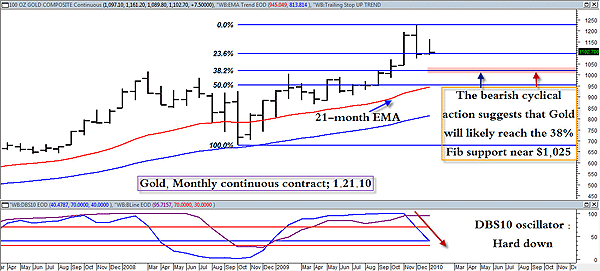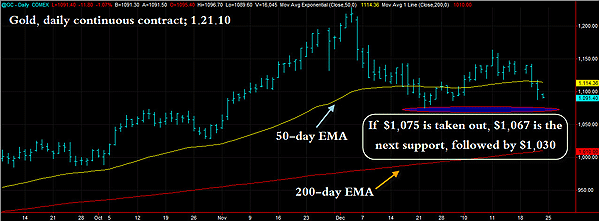
HOT TOPICS LIST
- MACD
- Fibonacci
- RSI
- Gann
- ADXR
- Stochastics
- Volume
- Triangles
- Futures
- Cycles
- Volatility
- ZIGZAG
- MESA
- Retracement
- Aroon
INDICATORS LIST
LIST OF TOPICS
PRINT THIS ARTICLE
by Donald W. Pendergast, Jr.
Despite a modest relief rally, gold has resumed its major monthly cyclical downtrend. At what support level might this metal finally bottom out?
Position: Sell
Donald W. Pendergast, Jr.
Donald W. Pendergast is a financial markets consultant who offers specialized services to stock brokers and high net worth individuals who seek a better bottom line for their portfolios.
PRINT THIS ARTICLE
CYCLES
Gold Falling Like A Ton Of Lead
01/22/10 09:49:18 AMby Donald W. Pendergast, Jr.
Despite a modest relief rally, gold has resumed its major monthly cyclical downtrend. At what support level might this metal finally bottom out?
Position: Sell
| The December 2009 high in gold was projected by various market technicians to coincide with the $1,200 price level (based on a variety of cyclical, Fibonacci, and resistance studies), and once it headed south it did so with little hesitation, dropping down to $1,075 in only three weeks. The bear market rally that ensued was bullish enough to cause the faithful to believe that this was nothing more than a standard pullback against an intact uptrend, but nothing could be farther from the truth. In fact, basic cycle analysis confirms that gold is likely destined to fall at least another $50 to $100 (if not more) before it hits support levels strong enough to engender another round of base-building. Let's have a look at the monthly chart of gold now (Figure 1). |

|
| FIGURE 1: GOLD, MONTHLY. The strong downward thrust in gold's monthly cycle suggests that a move down to $1,025 — the Fibonacci 50% support level — is very probable. |
| Graphic provided by: MetaStock. |
| Graphic provided by: WB DBS10 EOD from ProfitTrader for MetaStock. |
| |
| At present, monthly gold (continuous contract) is resting right at the Fibonacci 23.4% support level (calculated from the October 2008 to December 2009 upthrust), and as anyone familiar with trend reversal dynamics already knows, that particular Fibonacci retracement level is usually just a temporary stopping-off point before continuing with a move down to the Fibonacci 38% or 50% retracement levels. The main reason this appears to be what will come to pass is the current state of the DBS10 cycle oscillator (blue oscillator at bottom of chart); it's in "hard-down" mode, with plenty of room to run before it reaches oversold readings. Given the high reliability of this oscillator to follow through, it appears that shorting gold here, hoping for a move down to at least the Fibonacci 38% level at $1,025, is a reasonably sane course of action. Just below that level is the March 2008 high at $1,014, an area of support that will be a line in the sand as far as determining the health of the long-term uptrend in gold goes. Now let's check out the daily chart of gold, noting other coincident support levels that might also help establish a rational price target for those already short gold and/or for those ready to take the plunge. |

|
| FIGURE 2: GOLD, DAILY. If December's low of $1,075 is taken out, $1,067 is the next Fibonacci support zone, followed by various supports near $1,030, $1,025, $1,014, and $1,010. |
| Graphic provided by: TradeStation. |
| |
| The daily Fibonacci levels (not shown here) tells a similar story; the 50% Fibonacci support comes in at $1,067, the 62% Fibonacci resides at $1,030 and the 200-day exponential moving average (EMA; see red line) sits near $1,010. With daily gold having made another convincing close beneath its 50-day EMA (yellow line on chart), there appears to be little support now other than the December swing low at $1,075 (see ellipse). If this low is taken out, expect another wave of selling that should make the trip down to $1,067 in record time. Every tick in the gold market (0.10) is worth $10, so this could be a way to pick up about $700 in a session or two if the selloff proceeds as anticipated. For those selling near $1,095 (the price of April 2010 gold as I write this), a drop to that first daily Fibonacci level would mean about $2,800 in pretax profits. If you use the 50-day EMA (near $1,114.50) as your stop-loss, your initial risk on the trade would be about $950 and the profit target would be almost three times that at $2,800. Given the powerful downward pressure in the gold market, finding a trade setup with a risk-reward ratio of 3:1 is a wonderful thing, especially since the monthly cycle is likely to move substantially lower. |
| More conservative traders can configure the same basic trade using GLD or with minigold futures contracts. Run a three-bar trailing stop of the daily highs until the $1,067 to $1,070 area approaches and then close the trade down for a profit, especially if trading the full-sized COMEX gold futures (GCJ10) contracts. The February 2010 contract has much more liquidity than the April contract and should be the contract of choice. This looks like a relatively low-risk trade, one that has plenty of technical and fundamental advantages in its favor. If your margin account can handle the action, this could be a memorable and potentially profitable daily trade setup. |
| Bottom line, there is little to hold gold up on the way down to the daily Fibonacci 50% retracement level near $1,067, especially if the December low at $1,075 is taken out on a daily close. Beneath that price zone, various Fibonacci chart and EMA support spans the range from $1,030 to $1,010, with the March 2008 swing high at $1,014 being of major import in the overall scheme of things. Keep a close eye on price action, should it get that low; there should be volatile (and probably tradable) moves in either direction if it arrives there. |
Donald W. Pendergast is a financial markets consultant who offers specialized services to stock brokers and high net worth individuals who seek a better bottom line for their portfolios.
| Title: | Writer, market consultant |
| Company: | Linear Trading Systems LLC |
| Jacksonville, FL 32217 | |
| Phone # for sales: | 904-239-9564 |
| E-mail address: | lineartradingsys@gmail.com |
Traders' Resource Links | |
| Linear Trading Systems LLC has not added any product or service information to TRADERS' RESOURCE. | |
Click here for more information about our publications!
Comments
Date: 01/24/10Rank: 5Comment:
Date: 01/28/10Rank: 5Comment:

|

Request Information From Our Sponsors
- StockCharts.com, Inc.
- Candle Patterns
- Candlestick Charting Explained
- Intermarket Technical Analysis
- John Murphy on Chart Analysis
- John Murphy's Chart Pattern Recognition
- John Murphy's Market Message
- MurphyExplainsMarketAnalysis-Intermarket Analysis
- MurphyExplainsMarketAnalysis-Visual Analysis
- StockCharts.com
- Technical Analysis of the Financial Markets
- The Visual Investor
- VectorVest, Inc.
- Executive Premier Workshop
- One-Day Options Course
- OptionsPro
- Retirement Income Workshop
- Sure-Fire Trading Systems (VectorVest, Inc.)
- Trading as a Business Workshop
- VectorVest 7 EOD
- VectorVest 7 RealTime/IntraDay
- VectorVest AutoTester
- VectorVest Educational Services
- VectorVest OnLine
- VectorVest Options Analyzer
- VectorVest ProGraphics v6.0
- VectorVest ProTrader 7
- VectorVest RealTime Derby Tool
- VectorVest Simulator
- VectorVest Variator
- VectorVest Watchdog
